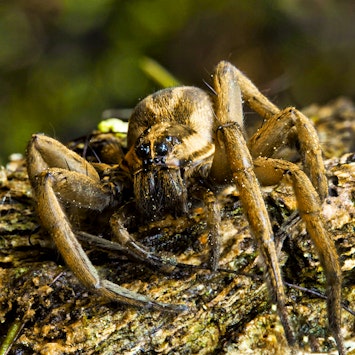
As their name implies grass spiders are usually found outside. Wolf spiders are hunters not web builders and only wander indoors by accident. They have mottled brown grey colors that camouflage them outdoors.

But their bites can be painful. They can grow up to 2 and they aren t poisonous. Though it is possible to see them in the daytime carolina wolf spiders are nocturnal and are usually spotted by people at night.

It seeks out and attacks. It does not wait for prey to get tangled in an intricate web. The carolina wolf spider is a skilled hunter not a trapper like other spiders.

It s in a genus called hogna and all of the hogna species are large and can be a bit difficult to identify. With a body and legs that can measure up to four inches in length it s often cited as the largest native wolf spider. Welcome to south carolina spiders where the large carolina wolf spider is recognized as the official state spider.

Members of this species are known to live in burrows that they dig. The body length of females is typically 25 millimetres 0 98 in and the body length of males is typically around 19 mm 0 75 in. Hogna carolinensis also known as the carolina wolf spider is usually regarded as the largest of the wolf spiders found in north america.

It is hairy and orangish brown to gray and black with splotches or stripes that give it a camouflage look. Here are some characteristics that make it a little different from other spiders. Like wolves they chase and leap on their prey.

The wolf spider can range from 1 2 inch to two inches long.
Carolina wolf spider range. Both in the coastal and the inland areas including woodland shrublands alpine meadows wet coastal forest suburban gardens and homes around human habitats. The carolina wolf spider is an american wolf spider and one of the 2 200 wolf spider species found across the world. Hogna is the genus with the largest of the wolf spiders. Among the hogna species in the u s the nearly solid dark brown h.
Carolinensis carolina wolf spider is the largest with a body that can be more than 2 5 cm 1 in long. The spider species hogna carolinensis commonly known as carolina wolf spider belongs to the genus hogna in the family lycosidae hogna carolinensis spiders have been sighted 32 times by contributing members. Based on collected data the geographic range for hogna carolinensis includes 1 countries and 13 states in the united states. Hogna carolinensis is most often sighted outdoors and.
Species hogna carolinensis carolina wolf spider. Throughout the united states. Open areas fields grasslands pastures meadows and deserts. They can be found under rocks during the day.
Considered to be the largest wolf spider in north america. The carolina wolf spider is a good display species for any invertebrate collection. Throughout the united states and southern canada. Terrestrial but will burrow to some extent.
Spiderlings eat flightless fruit flies and pinhead crickets. Adults eat crickets and other large insects. What the wolf spider looks like.

What the wolf spider looks like. Adults eat crickets and other large insects. Spiderlings eat flightless fruit flies and pinhead crickets.

Terrestrial but will burrow to some extent. Throughout the united states and southern canada. The carolina wolf spider is a good display species for any invertebrate collection.

Considered to be the largest wolf spider in north america. They can be found under rocks during the day. Open areas fields grasslands pastures meadows and deserts.

Throughout the united states. Species hogna carolinensis carolina wolf spider. Hogna carolinensis is most often sighted outdoors and.

Based on collected data the geographic range for hogna carolinensis includes 1 countries and 13 states in the united states. The spider species hogna carolinensis commonly known as carolina wolf spider belongs to the genus hogna in the family lycosidae hogna carolinensis spiders have been sighted 32 times by contributing members. Carolinensis carolina wolf spider is the largest with a body that can be more than 2 5 cm 1 in long.

Among the hogna species in the u s the nearly solid dark brown h. Hogna is the genus with the largest of the wolf spiders. The carolina wolf spider is an american wolf spider and one of the 2 200 wolf spider species found across the world.

Both in the coastal and the inland areas including woodland shrublands alpine meadows wet coastal forest suburban gardens and homes around human habitats.






